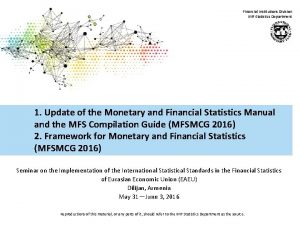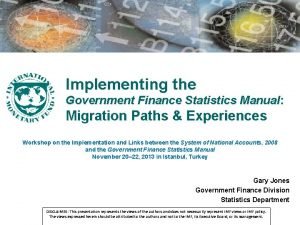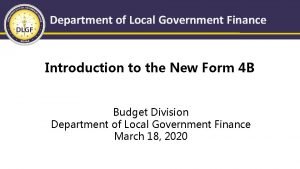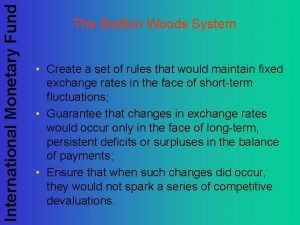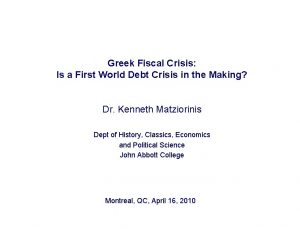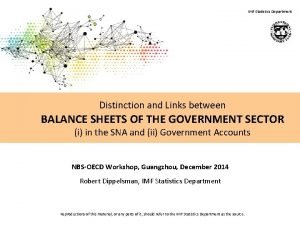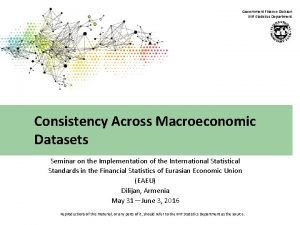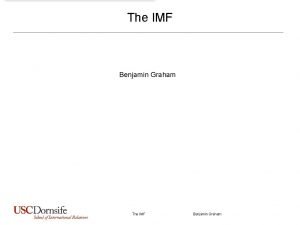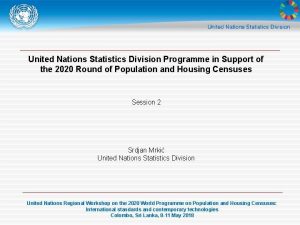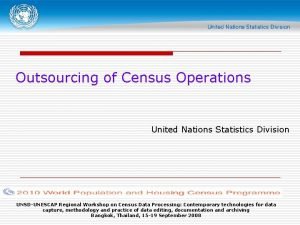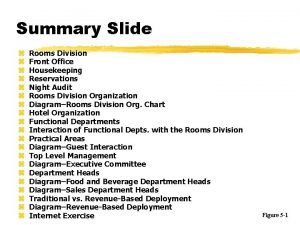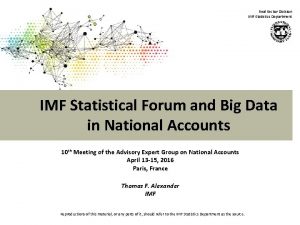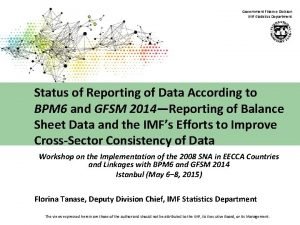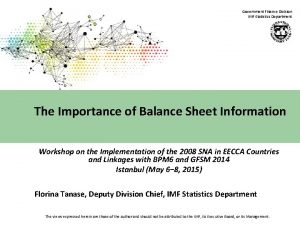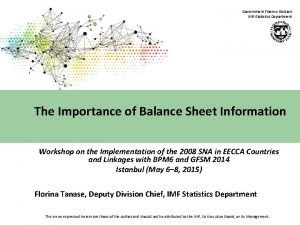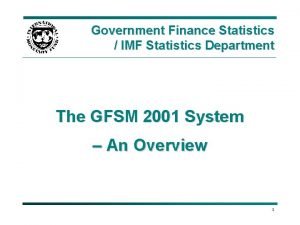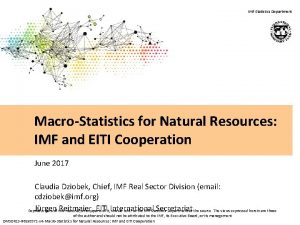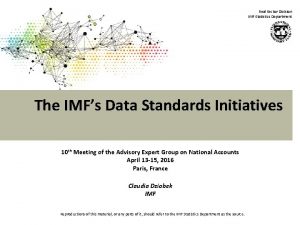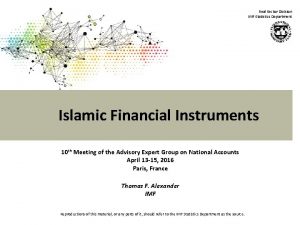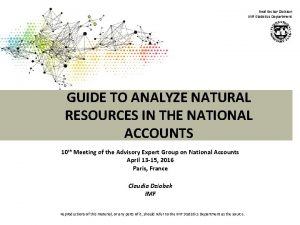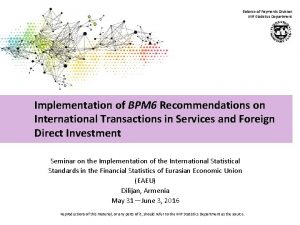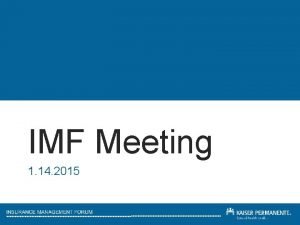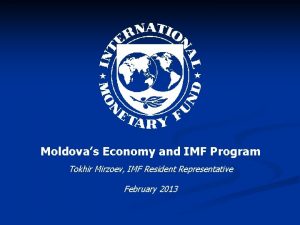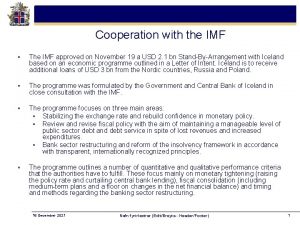Government Finance Division IMF Statistics Department Government Finance

































- Slides: 33

Government Finance Division IMF Statistics Department Government Finance Statistics - A Global Perspective Session 2, Friday June 13 Claudia Dziobek, Division Chief, IMF Eurostat Conference, The Accounts of Society, Luxembourg, June 12 -13, 2014 The views expressed herein are those of the author and should not be attributed to the IMF, its Executive Board, or its Management.

Government Finance Division IMF Statistics Department “The global crisis demands bold initiatives to rescue the financial sector and boost aggregate demand. . Since monetary policy is at the end of its rope, early, strong, and carefully thought-out fiscal policies are urgently needed. Time and action are of the essence if we are to avoid a contraction larger than any we’ve seen since the 1930 s” IMF Economic Counselor, Blog 2009 2

Government Finance Division IMF Statistics Department With the recent financial and economic crisis, demand for more timely, more comprehensive and comparable fiscal data has increased dramatically. The global nature of the crisis and globally coordinated responses put the spotlight on data comparability. This presentation documents the dramatic increase in demand for government finance statistics, some bold responses by statisticians, and key challenges ahead. 3

Government Finance Division IMF Statistics Department Dramatic Increase in Demand for Fiscal Data: Some Examples § IMF’s Fiscal Monitor established in 2009 § Debt Sustainability Analysis (DSA) modernized 2011 § Debt Management Guidelines updated in 2014 § Europe: “Six Pack” Council Directive /85/EU adopted in 2011 § Africa: regional fiscal data harmonization s (EAC, WAEMU) 4

Government Finance Division IMF Statistics Department Fiscal Monitor Launched in 2009 D ++ § § § • • Analysis of public finance developments Update of fiscal implications of the crisis Medium-term fiscal projections Assessment of sustainable public finances Published twice a year by the IMF … presents a wealth of fiscal data and analysis and covers some statistical issues (e. g. SNA 2008, pension obligations, fiscal data revisions during the crisis; public debt, nonfinancial assets. ) …challenges statisticians to provide more and timely fiscal data. 5

Government Finance Division IMF Statistics Department D ++ Debt Sustainability Analysis for Market. Access Countries Modernized in 2011 Central Government Gross Debt (% GDP) “Modernizing the framework for fiscal policy and public debt sustainability analysis (DSA) has become necessary, particularly in light of the recent crisis and rising sustainability concerns in some advanced economies. …” ‘Level of scrutiny’ trigger: Is public debt over 50 -60 % of GDP? Post crisis debt 6

Government Finance Division IMF Statistics Department D ++ Debt Sustainability Analysis (cont) § In 2011, the IMF adopted a risk-based approach to DSAs for all market-access countries § Data coverage to be based on internationally recognized statistical methodology § § High risk state-run enterprises to be assessed Gross and net debt may be assessed Health and pension related issues to be addressed Contingent liability module added 7

Government Finance Division IMF Statistics Department D ++ IMF Debt Management Guidelines Updated in 2014 § Designed to assist policymakers to strengthen the quality of public debt management and reduce their country’s vulnerability to domestic and external shocks. § Institutional and instrument coverage to be specified § High priority: accurate debt recording and reporting systems • “This is required … for producing debt data and ensuring timely payment of debt service, … for improving the quality of budgetary reporting and the transparency of government financial accounts. ” • “The management information system should capture all relevant cash flows, and should be fully integrated into the government's accounting system. ” 8

Government Finance Division IMF Statistics Department EU “Six Pack” Raises the Bar for Fiscal Data D ++ § Council Directive 2011/85/EU on requirements for budgetary § § frameworks of the Member States is part of the Enhanced Economic Governance package (so-called "six pack“ adopted by the European Parliament and Council in 2011. Accounting system to be suitable for ESA general government data Public availability of datasets that are highly relevant for fiscal monitoring • timely high-frequency data for all general government subsectors • bridge table between public accounts and ESA data • data on contingent liabilities and other indicators having potential impact on the fiscal stance (guarantees, debt of public corporations, PPPs, pensions, nonperforming loans). 9

Government Finance Division IMF Statistics Department Africa: Fiscal Data Harmonization Efforts § West African Monetary Union (WAEMU) § In 2009, common fiscal reporting format including balance sheet based on GFSM 2001 was adopted § Full implementation starting 2017 § Donor support and regional government finance statistics advisor since 2007 § East African Monetary Union project (EAMU) § Convergence criteria • fiscal deficit and gross public debt • based on the GFSM 2001/2014 methodology • high-frequency and annual GFS data by 2017 § Donor support and government finance statistics advisors in the region since 2014 10

Government Finance Division IMF Statistics Department R Responses to Increased Data Demand Steps to Strengthen Fiscal Data § IMF Staff Reports: internationally comparable fiscal tables (GFSM) § G-20 Data Gaps Initiative launched in 2009 § Statistical Manuals updated (GFSM 2014) § Government Finance Statistics Advisory Committee created § International Public Sector Accounting (IPSASB) – cooperation intensified § Fiscal Transparency Code and Assessments upgraded 2013 § Research and Communication to explain statistical concepts, motivate reporting 11

Government Finance Division IMF Statistics Department IMF Staff. Reports Good progress … Over time, all IMF staff reports are to present fiscal tables in globally comparable format (Government Finance Statistics Manual, GFSM). IMF Executive Board decisions (2010, 2013) Staff Reports Including a GFSM Presentation of Fiscal Data 140 19 120 19 Number of Countries 9 80 20 7 6 8 11 19 17 10 0 19 20 WHD 18 60 40 20 14 100 26 39 33 38 11 Oct 11 Jan 12 EUR APD 29 23 23 26 20 23 24 29 Apr 12 Jul 12 Dec 12 Jun 13 17 8 MCD AFR 12

Government Finance Division IMF Statistics Department IMF Staff Reports reflect countries’ limited capacity Countries Reporting Data on Government Balance Sheets 70 60 18 50 16 40 25 30 20 10 0 51 46 71 23 13 8 12 2004 GFSY 2008 GFSY Full balance sheet 29 Financial balance sheet 24 2013 GFSY Liabilities only Source: Government Finance Statistics Yearbook (GFSY) 13

Government Finance Division IMF Statistics Department G-20 Data Gaps Initiative § The G-20’s Working Group on Reinforcing International Co- operation and Promoting Integrity in Financial Markets asked the IMF and the Financial Stability Board (FSB) Secretariat to explore information gaps and provide appropriate proposals for strengthening data collection § IMF and the FSB Secretariat presented a report in November 2009 with 20 recommendations to close information gaps in the areas of: • • Risk in Financial Sector Cross Border Financial Linkages Vulnerability Communication of Official Statistics: Principal Global Indicators (PGI) created 14

Government Finance Division IMF Statistics Department G-20 Data Gaps Initiative Government Finance Statistics Recommendation 17. “The IMF to promote timely and cross-country standardized and comparable government finance data based on the accepted international standard, the Government Finance Statistics Manual 2001 (GFSM 2001). Template for Best Practices on the PGI website: Quarterly General Government, Integrated Stocks and Flows Dissemination on a timely basis with appropriate detail. Recommendation 18. “The World Bank, in coordination with the IMF, and consulting with the Inter-Agency Task Force on Finance Statistics (TFFS), to launch the public sector debt database in 2010. ” 15

Government Finance Division IMF Statistics Department G 20 Data Gaps Initiative PSDS Created in 2010 Quarterly Public Sector Debt Statistics Online Database (QPSDS Currently over 70 countries report quarterly gross debt, promoting consistent data across international organizations based on Public Sector Debt Statistics methodology Can be accessed at www. worldbank. org/qpsd 16

Government Finance Division IMF Statistics Department Methodological Manuals have been updated § Government Finance Statistics Manual 2014 • Comprehensive set of integrated accounts § Harmonized with SNA 2008 and ESA 2010 § Supporting Manuals • • • Public Sector Debt Statistics: Guide for Compilers and Users (2011) Developing Country Guide (2011) Quarterly Guide for Government Finance Statistics (2013) 17

Government Finance Division IMF Statistics Department Government Finance Statistics Advisory Committee (GFSAC) § GFSAC created in 2009 for global consultation on update of GFSM in line with 2008 SNA § Two meetings held in Washington § GFSAC with broader mandate to advise on development of government finance statistics to be launched by the IMF in 2015 (membership by invitation) 18

Government Finance Division IMF Statistics Department Methodological guidance is well developed and globally comparable 19

Government Finance Division IMF Statistics Department Government Finance Statistics and IPSASB § Accounting data - key source of government finance statistics § Harmonization with internationally recognized accounting standards intensified since the crisis. • • IMF represented in International Public Sector Accounting Standards Board (IPSASB) IPSASB represented in GFS Advisory Committee § Partnership resulted in: • • GFSM 2014, Appendix 6 IPSASB Consultation Paper, IPSASs and Government Finance Statistics Reporting Guidelines 20

Government Finance Division IMF Statistics Department Updated Fiscal Transparency Code (2013) § Update reflects lessons of the crisis and greater emphasis on statistical methodology: • • • broader institutional coverage of fiscal reports, more comprehensive information about government balance sheets, more frequent and timely fiscal reporting, better analysis of fiscal risks, sub-national entities and public corporations, improved consistency between fiscal forecasts, in-year fiscal reporting, and year-end fiscal data. § Six country assessments have been conducted jointly by the Fiscal Affairs and Statistics Departments under the new framework 21

Government Finance Division IMF Statistics Department Research to Explain Statistical Concepts ‘What Lies Beneath: The Statistical Definition of Public Sector Debt’ 22

Government Finance Division IMF Statistics Department Research … to Showcase Stock Flow Adjustments A Partial View: Gross Debt minus Deficit A Complete View: Includes “Other Economic Flows” Discrepancies are significantly lower where stock-flow residual is correctly measured! 23

Government Finance Division IMF Statistics Department Research … Institutional Structure of Government Starting with the National Accounts Sectors Government and Other Sectors of the Economy General Government Sector (GL 3) Nonfinancial Corporations Sector Financial Corporations Sector Households Sector Nonprofit Institutions Serving Households Sector 24

Government Finance Division IMF Statistics Department GL 3 – General Government GL 2 – Central Government GL 1 – Budgetary Central Government: Judiciary, legislature, ministries, presidency, and government agencies. State Government: States and provinces Extra-budgetary units/accounts Social Security Funds 1: National social security Local Government: Municipalities 1 In some countries, social security funds are not part of the central government in terms of legal arrangements. However for comparability in the Government Finance Statistics Yearbook they are included outside GL 1 and inside GL 2.

Government Finance Division IMF Statistics Department Research: Fiscal policy analysis is often limited to budget data for developing countries Budgetary Expense as a Percentage of General Government Expense (Unconsolidated 2012) 26

Government Finance Division IMF Statistics Department Research: The Significance of Extrabudgetary Units in Central Government The Number of Extrabudgetary Units for Selected Countries Note: these are not included in Budgetary Fiscal data 27

Government Finance Division IMF Statistics Department Research: Even central government data are only a partial view of government Central Government Expense as a Percentage of General Government Expense (Unconsolidated 2012) 28

Government Finance Division IMF Statistics Department Research: The Role of Nonfinancial Assets in Debt and Deficit Management General Government Assets and Liabilities (Percent of GDP) 29

Government Finance Division IMF Statistics Department Some Success in Motivating Countries to Report to the IMF’s Global Database Number of Countries Reporting Data for the GFSY (in GFSM format) Source: Government Finance Statistics Yearbook GFSY) 30

Government Finance Division IMF Statistics Department Moving Beyond General Government A next horizon in public finance statistics GFSM and Fiscal Transparency Code Place more emphasis on Public Sector – but data are not available for many countries General Government Sector Nonfinancial Corporations Sector Financial Corporations Sector Public Sector Private Households Sector Nonprofit Institutions Serving Households Sector Private Additional Information for Assessing Fiscal Vulnerabilities and Risk 31

Government Finance Division IMF Statistics Department Conclusions and What’s Next ? § Surge in demand for fiscal data – will not go away. § Global statistical community has taken major steps to address § § fiscal data requirements since the financial crisis. Methodological frameworks are in place. Globally comparable, timely, and accessible data are lagging: Quarterly general government data (released within a quarter) Balance sheet data: full instrument/institutional coverage of debt and assets Source data: Linking budget data with government finance statistics Data on pension, health, and other functions of government Further down the road: Data on the public sector 32

Government Finance Division IMF Statistics Department What Next ? Focus on dissemination of government finance statistics, especially general government Persuade all countries to invest in government finance statistics and produce comprehensive, timely, internationally comparable fiscal data Continue to foster link between fiscal policy and data dissemination Continue to develop link between accounting and statistics Government Finance Statistics Advisory Committee for global initiatives 33
 Imf financial statistics
Imf financial statistics Financial institutions division
Financial institutions division Government finance statistics manual
Government finance statistics manual Department of local government finance
Department of local government finance Imf history
Imf history Imf adalah
Imf adalah Types of intermolecular forces
Types of intermolecular forces Difference between imf and world bank
Difference between imf and world bank Materi tentang lembaga keuangan internasional
Materi tentang lembaga keuangan internasional Imf voting power
Imf voting power India imf loan history
India imf loan history Imf practice
Imf practice Objectives of imf
Objectives of imf Imf chemistry
Imf chemistry Imf system
Imf system Debt imf
Debt imf Lambang imf
Lambang imf Imf chemistry
Imf chemistry Imf
Imf Department vs division
Department vs division Imf
Imf Imf gdp per capita
Imf gdp per capita Molecular attraction
Molecular attraction Imf
Imf Introduction to statistics what is statistics
Introduction to statistics what is statistics United nations statistics division
United nations statistics division United nations statistics division
United nations statistics division Mohari botanical name
Mohari botanical name Division of academics department of mathematics
Division of academics department of mathematics Department vs division
Department vs division What are the 5 areas of room division
What are the 5 areas of room division Room division department
Room division department Short division vs long division
Short division vs long division Synthetic dividend
Synthetic dividend

